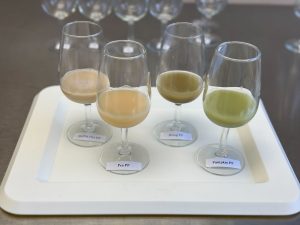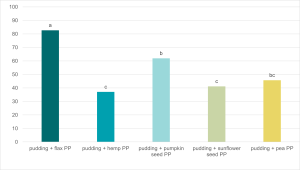The sensory characterization of
plant-based proteins
Plant-based protein powders are used as a functional food ingredient and sold directly to consumers, for example to make a high-protein smoothie at home. While plant-based protein products are growing in popularity, there can be challenges related to off-flavours and unfavourable textures and there are few studies on their sensory profiles.
What we did
This summer Vineland’s trained sensory panel completed a project characterizing the flavour diversity of plant-based protein powders. We tested protein powders in both a neutral background (water) and in several food applications (like chocolate pudding) and learned several key lessons.

Plant-based protein powders
We included 10 single plant source, unsweetened, commercially available plant-based protein powders in the study:
| Protein type | Percent protein | |
| 1 | pea | 83% |
| 2 | brown rice | 80% |
| 3 | spent grains | 40% |
| 4 | sunflower seed | 53% |
| 5 | hemp seed | 75% |
| 6 | soy | 83% |
| 7 | flax seed powder | 33% |
| 8 | fava bean | 55% |
| 9 | pumpkin seed | 68% |
| 10 | mushroom | 24% |
Lesson #1: Fatiguing product
We developed protocols to help with tasting, including a two-minute forced break between each sample during which panelists were instructed to rinse with sparkling water to help remove the tastes and flavours of the previous samples and decrease their sensory fatigue.
Lesson #2: Diverse and intense profiles
To describe the sensory profiles of the protein powders we developed a lexicon (13 aromas, five tastes and six mouthfeels) and performed descriptive analysis. This resulted in a sensory configuration of diverse and intense sensory profiles (Figure 1). Products were grouped into six product clusters based on similar profiles, for example:
Cluster 1: mushroom protein powder: mushroom, seaweed, earthy aroma and acidic, bitter, salty and strong umami taste with an astringent, thin and gritty mouthfeel.
Cluster 2: brown rice, pumpkin seed, sunflower seed and soy protein powders: cereal/grainy, doughy, carboard and nutty aromas and mouthcoating, chalky and medium-gritty mouthfeel.

Lesson #3: Background matters
We conducted experiments to understand the impact of different backgrounds (orange juice, chocolate pudding, vanilla yogurt and a green smoothie) and different protein powders (pea, hemp, flax, pumpkin seed, sunflower seed) in chocolate pudding. Significant differences were found. For example, pudding + flax protein powder was perceived to be the most different (83%) compared to the plain chocolate pudding.

This research project led to important insights into the sensory evaluation of plant-based protein powders; information that is key to understanding the sensory profiles and consumer acceptance of this emerging product category.
The main highlights of this project were recently presented at the 2024 SSP (Society for Sensory Professionals) Conference in Pittsburgh, PA.
Questions? Looking for more information?
Amy Bowen, PhD, Director, Consumer, Sensory & Market Insights
amy.bowen@vinelandresearch.com, 905-562-0320 x5805
